The goal Eng Teng set himself on graduating from NAFA in 1961 was modest; he planned to teach on a part-time basis. He aimed to do so not by joining an institution but on a private arrangement; he would advertise for students, and tutor them according to a mutually convenient schedule. It marked a small step towards securing a degree of financial independence; it was also a step taken to test the ground for commencing a practice and gaining a moderate niche for it. These intentions were not extraordinary; many who set out to develop careers as practicing artists have pursued similar pathways, and many continue to do so. For Eng Teng, however, a beginning such as this did not materialise; events moved not only swiftly but in the most unexpected ways. Consequently the transition he planned enabling him to shift away from a state of dependent pupilage to acquiring a foothold in being moderately self-sufficient was aborted.
When he disclosed his intention to Georgette Chen, who asked him what he would do after graduation, she urged him to go beyond the realms of convention, to avoid the predictable, even if this entailed entering unfamiliar terrain. She suggested that he further his studies in ceramics. The proposal was, no doubt, startling as there were no precedents for embarking in that direction in Singapore. As Eng Teng recalls the occasion Georgette Chen as persuasive and she prevailed:
Mdm Chen had done some beautiful pots and pieces of ceramics when she was in France and these were displayed in her home. So on rare occasions when I visited her, I got very excited with these works. She remarked: 'They are very easy to make and technically very simple'; she suggested why don't I go and do ceramics. My parents were not well-off and they had to support two other children overseas. Nevertheless, Mdm Chen did say to learn to pot was not difficult, you could master the skill in just three to six months time. That sounded encouraging and I wanted to study; so I persuaded my parents. I set off for a three to six months duration of studies. But I remained for four years instead. There was so much to learn. (Conversations, p. 155.)
A number of matters arising from this disclosure deserve mention and elaboration. Firstly and obviously, Eng Teng was extremely interested in furthering his studies. Although he had acquired requisite schooling in painting, he did not regard it as marking the end of learning; the prospect of continuing studies appeared inexhaustible. Secondly, he met Chen's suggestion enthusiastically even as ceramics as a studio practice, as a creative enterprise, was unknown here; he may well have discerned, with Chen, the pioneering aspect of such an undertaking and was willing to meet with the risk and challenge. Thirdly, Georgette Chen's advice sprang from an inclusive vision of creativity, one which was shaped by her experience and knowledge of art in the international arena, especially as manifested in Paris. Accordingly, she encouraged Eng Teng to leap over prevailing limitations, to skirt conventional definitions of visual creativity (invariably confined to painting and sculpture), and prospect other media and new materials. This last mentioned matter is not an exaggerated claim; when Eng Teng returned after completing his studies in England, he approached NAFA with the aim of introducing a programme in ceramics in its curriculum, as if to vindicate Chen's vision. The academy turned him down, steadfastly upholding painting as the defining criterion for fine arts and for creativity. For that matter, Eng Teng's entry into the world of ceramics was not without complications; the development of his ceramic practice was difficult and painstaking. However, one event needs to be considered before dealing with some of the intricacies that characterise Eng Teng's final phase of his studentship in England and the inauguration of his practice in Singapore in 1966.


 In February 1962, weeks prior to his departure for England, Eng Teng held an exhibition with Katherine A. Schmid-Audeoud, a French artist who had resided in Singapore for about ten years and devoted much of her time to developing her interest in art. Eng Teng displayed 90 works featuring paintings (in oil and ink), sculpture and drawings; it marked the largest exposition of his works, displaying the range of his ability and interest at that time. The show also marked his debut as an artist - or at least as one who possessed the necessary formal education in art and was flagging his intention to enter the art world as a practitioner. A number of compositions presented at this exposition are in the collection; among them are View from Bukit Timah Hill (in oil and ink), Mending Nets, Preparing Rice Flour, Old Age, Life is Hard (in oil and ink), In the Kitchen, Miss Vogue and Aboriginal Woman, all of which have been discussed in the preceding chapter.
In February 1962, weeks prior to his departure for England, Eng Teng held an exhibition with Katherine A. Schmid-Audeoud, a French artist who had resided in Singapore for about ten years and devoted much of her time to developing her interest in art. Eng Teng displayed 90 works featuring paintings (in oil and ink), sculpture and drawings; it marked the largest exposition of his works, displaying the range of his ability and interest at that time. The show also marked his debut as an artist - or at least as one who possessed the necessary formal education in art and was flagging his intention to enter the art world as a practitioner. A number of compositions presented at this exposition are in the collection; among them are View from Bukit Timah Hill (in oil and ink), Mending Nets, Preparing Rice Flour, Old Age, Life is Hard (in oil and ink), In the Kitchen, Miss Vogue and Aboriginal Woman, all of which have been discussed in the preceding chapter.
 Accompanying the exhibition was a modest publication with messages from Ho Kok Hoe, Georgette Chen and commentaries by Chen Chong Swee and Ma Ge. By any reckoning this is an impressive cast as it features prominent persons in the art world; their presence can be seen as authorising or legitimising Eng Teng's entry into that world. While Kok Hoe and Georgette Chen dispensed the obligatory salutations, the interlocutions by Chong Swee and Ma Ge are of interest as they provided critical references for gauging the appearance of a now artist and his potential; their remarks are the earliest appraisals of Eng Teng.
Accompanying the exhibition was a modest publication with messages from Ho Kok Hoe, Georgette Chen and commentaries by Chen Chong Swee and Ma Ge. By any reckoning this is an impressive cast as it features prominent persons in the art world; their presence can be seen as authorising or legitimising Eng Teng's entry into that world. While Kok Hoe and Georgette Chen dispensed the obligatory salutations, the interlocutions by Chong Swee and Ma Ge are of interest as they provided critical references for gauging the appearance of a now artist and his potential; their remarks are the earliest appraisals of Eng Teng.
Chen Chong Swee taught ink painting (Chinese painting) at the academy; in his writigns he consistently advanced the view that art must be accessible to the public and be connected with contemporary life. He vigorously repudiated any attempts at mystifying the operations of artistic activity or at obfuscating the purposes of art. He reiterates his position on this occasion as well; "In the past, some pretentious artists attempted to mystify art as something extraordinary, thereby distancing art further front public and contemporary life." Noting that the approaches of Eng Teng and Katherine Schmid are opposed to such tendencies, he endorses them and offers the following estimation of the former:
Today we are happy to see that the participants of this joint exhibition hold plagmatic and steadfast attitudes towards their search (for their art). Eng Teng is even willing to cast aside the dream of becoming a 'master'. He will venture overseas to London to study sculpture and ceramics, and to hone his talents in the field of industrial arts. Just based on the solid foundation that can be witnessed in this exhibition, we can only imagine how bright and shining his future achievements will be. ('Best wishes for the Joint Exhibition')
Eng Teng's acquisition and demonstration of a requisite body of foundational knowledge is underlined, applauded; arising from this, a forecast for a stellar future is made. Chong Swee then proceeds to approvingly cast Eng Teng as an artist who is uninterested in gaining status and one who is willing to turn his back on the prospects of fashioning a charismatic persona with a following. He interprets Eng Teng's interest in ceramics, sculpture and industrial arts as marking an alternative to, if not a rejection of, the master tradition of art in Singapore; a tradition in which painting and painters are accorded privileged, pre-eminent positions. Chong Swee is approving because, in part, Eng Teng's intentions widen the scope of artistic practice in ways that can touch, appeal to the public directly and, in part, his interests signal a sense of humility which is at variance with the acclamation of a 'master'.
Ma Ge, the foremost critic and commentator on art in Singapore and Malaya, similarly praises Eng Teng's aim to further his studies in ceramics and industrial art, as he believes that incorporating pure and applied arts can broaden the purpose and absorption of the ensuing productions immensely. Turning his attention to the works on display, he is unstinting in acclaiming Eng Teng's attainments over a relatively short period of time; he offers illuminating comments and insights into the formal and conceptual aspects of the compositions. In particular, he highlights the realist tenor and the expressive fervour of the paintings and sculptures. He then advances a forceful appraisal of the importance of Eng Teng's sculptural creations:
These insights are valuable for a number of reasons. Firstly, they point to a range of artistic modes or approaches that Eng Teng had crystallised at this exhibition, a range that straddled the representational and the abstract. Ma Ge's interpretation of compositions bridging such approaches underline both facility and purpose; at times, though, he is of the opinion that free reign given to facility is "reckless", leading to a disjuncture between content and method of execution. Secondly, the readings bring content in the works into prominence. For instance, in discussing compositions in the abstract mode the sobriety of the content is contrasted with the carefree nature of the production; significantly, content is palpable and stands apart. By and large, references to "realism" and the "realist" tenor of the paintings and sculptures are rooted in the forcefulness and evident appeal or legibility of the content; of course content is absorbed only when the method of conveyance is effective, and in this regard Ma Ge is attentive to resonances and nuances. Thirdly, and most interestingly, Eng Teng's sculptural works are moved to centre stage and seen to encapsulate the salient features distinguishing his oeuvre at this phase of his development. This is surprising as painting is his chief preoccupation. It is possible that Ma Go was receptive towards the sculptural productions as they appeared to inaugurate a new dimension in the art world in Singapore, and for this reason merited acclaim. Whereas the paintings demonstrated their precedents, their affiliations to properties in the dominant art practices of the time, as well as revealing Eng Teng's individuality, the sculptural works were indisputably distinct and compelling; Ma Ge could not cite or point to any parallel, comparable productions. It is therefore not surprising that he forecasts great promise for Eng Teng and proceeds to install him in a position of eminence. "These patient, studied works and their intrepid expressions are enough for us to name him, without a doubt, as a fine sculptor of Malaya." (Ibid.)His portraits, people, sceneries all reach a culmination in his sculpture works, for they display the multi-faceted characteristics of realism, expressionism and abstraction. In his early years, he used plaster-of-paris as a medium. Recently, he ventured to create fired-clay and ceramic works, and experimented on creating busts and form studies from ciment fondu. In the realist busts, the likenesses emanate subtle expressions of thought and mood portrayed, In his abstract works are found carefree, reckless expressions amidst the sombre contents. ('Foreword')
These commentaries by Chen Chong Swee and Ma Ge are the earliest published appraisals of Eng Teng. How was the exhibition received by the public? There was considerable coverage in the news media, illustrated with photographs of art works and also of the artists; the reports revolved around the importance of the meeting of the East and the West and its promising consequences, and the personal circumstances in which the two participants developed their respective interests in art. Interestingly, in one account carrying the curious headline French Woman, Local Artist to Hold Show, it was related that the two met while studying at NAFA and that "they found out that they both had a common interest - painting"; (The Free Press, Febuary 24, 1962.) this contrasts with the reviews by Chong Swee and Ma Ge, in which they preferred to highlight engagements other than painting.
There was little attention given to reviewing the exposition, to teasing out meanings and significance; there were anecdotal inferences whose usefulness in appreciating the works is, at best, tenuous. For instance in a report featured in a section devoted Mainly For Woman, the reporter describes Eng Teng as "an aspiring young man who has won several prizes in local contests" and proceeds to disclose that "Mr Ng obviously has an eye for feminine beauty. His paintings (20 of them) are portraits of Asian women and girls." (Evelyn, Tu. 'A joint exhibition by two young artists' in The Straits Times, Febuary 27, 1962.) The account has been written to satisfy the perceived expectations of the readers of the section and even then to fulfill those with particular dispositions or yearnings. In this situation, Eng Teng is advanced as a suitable candidate for gratifying those yearnings.
In this account too, there appears a reference with altogether different ramifications; towards the end of the report it is said that "The exhibition holds more for Mr Ng. It conveys a special farewell message to the school from which the has recently graduated and to teacher Madame Georgette Chen." (Ibid.) Seen in this light, the show assumes wider significance. Yes, it marks the end of his pupilage at the academy and a demonstration of his ambition to strike out on his own. More than this, it also signals Eng Teng's resolve to measure his attainments at a critical moment of his development, a moment defined end of one phase and the beginning of another. The transition is of particular relavance as he is leaving to further his studies in England, which was seen as the fountainhead of intellectual and technical knowledge; in these circumstances it was important to register a presence by which one is remembered and by which the return can he he judged or qualified. Eng Teng was not alone in signposting his rites of passage in this way, it is a strategy employed by those who choose to pursue art beyond the confines of the academy, and whose advancement entails studying further and living abroad.
The choice of Stoke-on-Trent School of Art was fortuitous and, to a large extent, ill-advised. The manager of heavy clay at Alexandra Brickworks, where Eng Teng had his clay figures fired, recommended it as he had graduated from the North Staffordshire College of Technology in Stoke-on-Trent. Eng Teng followed this lead, relying solely on his contact and suggestion. On arrival at the school he realised he was enrolled in an industrial ceramics course and regretted his decision:
Students were training to design mainly hollow wares for factory production, from mould making right up to various types of decoration like on-glaze, transfers, silkscreen, the whole process from model to the finished product. I did not think this was what I really wanted to do. (3 Dialogues, p. 24.)
Notwithstanding his disquiet, the description of the programme of study is accurate and, what is more, is not surprising. Stoke-on-Trent was the main centre for pottery making in the United Kingdom; the courses offered in the institution focused on technical and scientific training. The objective was to develop designers, technicians and managers for the pottery industry. And it must be remembered that the home of ceramic knowledge was largely in industry; that knowledge was applied to industrial production and had little to do with the studio potter. Indeed, studio pottery was a minor engagement; it was only in the 1950s that it earned some prominence in colleges of art in England, especially as the philosophy and attitudes expounded by Bernard Leach (1997-1979) gained a following and were established as the dominant tradition. In this regard the publication of Leach's A Potter's Book (in 1940) provided the voice for the studio pottery movement, and for many potters all over the world it remains a 'bible'. His designation of the pot as markedly human led him to describe the vessel in bodily terms, namely: the foot, belly, shoulder, neck and lip; these terms have been absorbed into the language of pottery and are indispensable in discussing and appreciating it.
Although Eng Teng was uncertain about the suitability of the programme at Stoke-on-Trent, he completed it; and it was not entirely futile or unrewarding. He gained knowledge of ceramic design, production techniques and marketing strategies. What is more, he impressed the industrial ceramic fraternity with his efforts; at his graduation exposition he was offered a position at a pottery factory in Ireland by a talent scouting body. He accepted the position and remained there for two years. Even as he was successful in these enterprises, Eng Teng did not consider industrial pottery as an enduring goal or profession. Consequently, throughout his studentship in England, and for the duration of his professional engagement as a designer, Eng Teng pursued a dual track. That is to say, while fulfilling the requirements of the course he had officially enrolled in, and while meeting with the expectations of a resident designer at the factory in Ireland, he developed his involvement in studio pottery parallelly.
For instance at Stoke-on-Trent, studio pottery was offered as a subject in the art school. Eng Teng enlisted in it; it was taught by inspiring teachers. He also made enquiries into programmes offered in other institutions; in this connection he visited Farnham School of Art in the county of Surrey, a school which was gaining a notable reputation in the teaching of studio pottery and fabric art. Eng Teng was impressed by what he encountered and registered to study ceramic art on completing his course at Stoke-on-Trent; in order to do so he waived the offer of a post in the factory in Ireland until after concluding his studies at Farnham. What is more, he laid a condition to the employers in Ireland, namely: that he be permitted to install a potter's wheel in his work place to enable him to throw his pots during leisure hours. All of these undertakings indicate Eng Teng's determination to advance his study of studio pottery, which was the aim of embarking upon the journey to England.
Industrial pottery and studio pottery are worlds apart, although there are material and technical aspects that are common to both. Eng Teng defines the difference by emphasising the subjective origins, aesthetic dimensions and uniqueness of each and every vessel produced as distinguishing criteria of studio pottery:
I would like to think of studio pottery in terms of art pottery; it is more personal. Each piece is created individually with your personality put into it. Of course you have to know all the technical aspects of pottery production which are similar to industrial pottery. You have to know the process. But in studio pottery you can put a lot of yourself in it, your personality; it is a very intimate sort of process. It starts with a lump of clay, throwing it on the wheel, developing it, looking at the shape, the balance of the form at every stage until it is complete. (3 Dialogues, p. 25.)
Anticipating the argument that however pottery may be approached or defined, it is predominantly a practice anchored in craft and one which is burdened by an unshakable tradition as well as utility, Eng Teng provides an intriguing disclosure to advance the creative and individual aspects of studio pottery:
Normally when we think of pottery, we think more in terms of its association with craft. This is a long association and difficult to break away from. Even now when you say you are a potter, a studio potter, people will think of you as a craftsman. Of course this is true, for if you throw from the wheel, any form that is created is no more a unique form because once upon a time some other potter has already come up with this form. So if you want to be an artist potter, you have to be more. (Ibid.)
Taken together these accounts bring into relief a range of issues that are germane to appraising Eng Teng's ceramic practice and to discussing the parameters of studio pottery; for the present two of them will be examined. Firstly, repeated mention is made of throwing; this is not surprising as it is central to hand-thrown pottery. It entails possessing requisite skills to shape a lump of soft clay by centring, turning it on the potter's wheel, shaping it into assuming, a cylindrical form or bowl shape. The procedure involves centering, opening the lump of clay, collaring in, pulling up, shaping and finishing. Eng Teng's initial encounter with studio pottery at Stoke-on-Trent and his subsequent sojourn at Farnham School of Art were devoted to gaining and deepening these facilities.
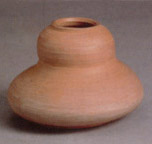 My Very First Pot, c. 1962 (Fig. 58) and Bowl, 1962 (Fig. 59), are among the earliest efforts in which the rudiments of hand-thrown pottery are tentatively, partially grasped. The former, which is gourd-shaped, sits almost directly on the ground; its foot is hardly visible and is not seen to have a function. The belly is extended and narrows swiftly into the neck: the tip is barely distinguishable. It bears the hallmark of a work by a novice. The bowl in Fig. 59 secures a firm presence; the wall curves evenly and terminates at the lip firmly, dccisively. The chief interest is in dealing with glazing techniques and effects; the interior, which is layered with turquoise glaze conveys a dense surface.
My Very First Pot, c. 1962 (Fig. 58) and Bowl, 1962 (Fig. 59), are among the earliest efforts in which the rudiments of hand-thrown pottery are tentatively, partially grasped. The former, which is gourd-shaped, sits almost directly on the ground; its foot is hardly visible and is not seen to have a function. The belly is extended and narrows swiftly into the neck: the tip is barely distinguishable. It bears the hallmark of a work by a novice. The bowl in Fig. 59 secures a firm presence; the wall curves evenly and terminates at the lip firmly, dccisively. The chief interest is in dealing with glazing techniques and effects; the interior, which is layered with turquoise glaze conveys a dense surface. 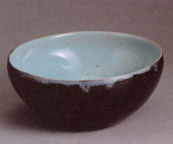
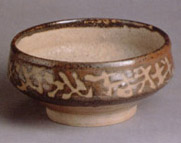 Yet, this coloured glaze is potentially capable of transmitting lustrous effects - and it is valued for these properties. A bowl illustrated in Fig. 60, also produced in 1962, demonstrates considerable advancement in these very areas which were found to be hesitant and insufficiently realised in the vessels described above. The foot, belly, lip and interior space are clearly shaped and defined: the relationship of these elements to one another is functionally explicit. The glaze is applied discreetly and purposefully; textures are varied in order to accommodate particular ornamental devices.
Yet, this coloured glaze is potentially capable of transmitting lustrous effects - and it is valued for these properties. A bowl illustrated in Fig. 60, also produced in 1962, demonstrates considerable advancement in these very areas which were found to be hesitant and insufficiently realised in the vessels described above. The foot, belly, lip and interior space are clearly shaped and defined: the relationship of these elements to one another is functionally explicit. The glaze is applied discreetly and purposefully; textures are varied in order to accommodate particular ornamental devices.
 When these vessels are compared with Teapot with Two Cups I, 1963 (Fig. 61), the differences between studio and industrial pottery are strikingly clear. Whereas in the former each endeavour leads to the creation of a distinct object bearing the marks of its labour, in the latter the vessel appears faultless and regulated. This is because the design for such productions is carefully measured so that it is capable of generating multiple numbers without variation and diminishing its shaping force; similarly, the process of production is also calculated and controlled in order to avoid flaws or deviations. The teapot and two cups
When these vessels are compared with Teapot with Two Cups I, 1963 (Fig. 61), the differences between studio and industrial pottery are strikingly clear. Whereas in the former each endeavour leads to the creation of a distinct object bearing the marks of its labour, in the latter the vessel appears faultless and regulated. This is because the design for such productions is carefully measured so that it is capable of generating multiple numbers without variation and diminishing its shaping force; similarly, the process of production is also calculated and controlled in order to avoid flaws or deviations. The teapot and two cups
 (the cup doubles up as a cover) demonstrate Eng Teng's capacity to effectively deal with the formal and technical aspects of industrial pottery. Eng Teng amplifies this facility to encompass different methods of applying ornament on vessels and dishes so as to enhance their pictorial appeal or value. This is vividly illustrated in Decorated Plate, 1963 (Fig. 62), in which the interior of a pre-manufactured object is decorated with on-glaze painting of a lotus flower. In another decorated plate (Fig. 63), 1963, Eng Teng employs the photolithography print technique to compose an image featuring three boats which is enhanced by applying black monochrome Over olive-green glaze; the motifs are recollected from the numerous drawings of riverscapes executed in Singapore over the years 1960 and 1961.
(the cup doubles up as a cover) demonstrate Eng Teng's capacity to effectively deal with the formal and technical aspects of industrial pottery. Eng Teng amplifies this facility to encompass different methods of applying ornament on vessels and dishes so as to enhance their pictorial appeal or value. This is vividly illustrated in Decorated Plate, 1963 (Fig. 62), in which the interior of a pre-manufactured object is decorated with on-glaze painting of a lotus flower. In another decorated plate (Fig. 63), 1963, Eng Teng employs the photolithography print technique to compose an image featuring three boats which is enhanced by applying black monochrome Over olive-green glaze; the motifs are recollected from the numerous drawings of riverscapes executed in Singapore over the years 1960 and 1961.
In viewing these vessels one is sufficiently impressed by Eng Teng's accomplishment as an industrial ceramist; his recruitment by the factory in Ireland is an endorsement of his achievements by the industry. Yet, it is in the realm of studio pottery that creative thinking and artistic innovation are constantly advanced; and it is in his engagement in studio pottery that Eng Teng makes significant contributions to ceramic activity here. Indeed, together with Iskandar Jalil, he is the foremost studio potter in Singapore.
Mention has been made of the initial encounter with studio pottery at Stoke-on-Trent; in this connection his earliest productions have been examined. Although undertaken as a supplementary subject, the exposure provided the foundations. It was when he transferred to Farnham School of Art in 1963 that his study of creative pottery deepened; not surprisingly, the vessels he produced display purpose and confidence, they also register distinct presences. The approach to studio pottery at this school sprang from the Leach tradition; consequently, while there was scrupulous attention to the craft dimension of the practice, there also was a passionate quest for individuality, sincerity and truthfulness. A pot was conceived as a genuine expression of life and implied truth in the conception and execution of the work. Eng Teng absorbed this principle.
For Eng Teng, as for all studio potters, throwing is the formative, defining process in studio pottery; his accounts, which are cited above, bear testimony to his avowal of throwing as manifesting the primary aesthetic credo. Mention has already been made of this process and of the stages involved in developing it. In studio pottery, throwing is more than a necessary procedure leading to the production of utilitarian vessels. Throwing is imbued with subjective yet Purposeful ambitions; it is in turn intuitive and skilful. It is identified with a force lodged deep inside the being which, in tandem with manipulating the soft clay, is released and actualised in the created vessel. And in the aesthetic reckoning of studio pottery a vessel is, first and foremost, a self-consciously expressive object; it is along these grounds that it is principally appreciated. This is not to say that function is completely neglected; on the contrary. Function continues to be invoked, although hesitatingly. In this regard Eng Teng concedes that "the contemporary studio potter strives to create works that enhance the environment and which at the same time can be used, although not necessarily so." (Ibid.) The ambivalence is striking; it underlines one of thc odder aspects of contemporary handmade pottery where functionally irrelevant objects are made in the guise of having some utilitarian ends. In these circumstances, the level of tolerance towards vessels whose performance is woefully inadequate is high, thereby exonerating the desire for aesthetic values over other considerations.
Eng Teng describes the process (of throwing and of creativity in studio pottery) as "intimate"; he also underlines the kinship between the thing made and the personality or world view of the maker. Consequently each vessel is "created individually with your personality into it". This can be read as related to aspects of the philosophy advocated by Bernard Leach. This is one component of Eng Teng's characterisation of creative or art pottery; the others deal with the requirement of skills and the relationship between the new and tradition. More on the last mentioned factor a little later on.
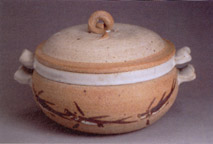 Three-piece Casserole Warmer I, 1964 (Fig. 64), marks an expansion of the technical and conceptual basis for the development of his pottery. The walls have been raised securely in order to provide firm contours and clearly defined inner spaces. Eng Teng enhances the textural properties of stoneware by employing glazes discreetly, thereby highlighting the burnished effects of firing clay to produce this particular ware; the body and lid are distinguished by a translucent glaze.
Three-piece Casserole Warmer I, 1964 (Fig. 64), marks an expansion of the technical and conceptual basis for the development of his pottery. The walls have been raised securely in order to provide firm contours and clearly defined inner spaces. Eng Teng enhances the textural properties of stoneware by employing glazes discreetly, thereby highlighting the burnished effects of firing clay to produce this particular ware; the body and lid are distinguished by a translucent glaze.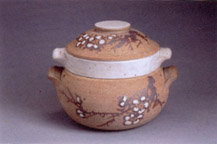 The surface at the widest extension of the belly is decorated with fish; they appear to swim in an orbit parallel to the circumference of the belly, thereby accentuating kinetic effects along this section of the vessel. The knob represents an eel, which is curled and raised to form a tight, functional element. Eng Teng takes great delight in creating representations of the natural world; with imagination and inventiveness he produces a range of images, many playful and which could easily function as toys, while others tease the eye and mind with their surprising combinations and metamorphosis. Fig. 65, 1964, illustrates another three-piece
casserole warmer; it is differentiated from Fig. 64 by it's proportions, the detailing of the handle and the knob of the lid, as well as the ornament. In these two productions equal attention is given to utility and aesthetic values.
The surface at the widest extension of the belly is decorated with fish; they appear to swim in an orbit parallel to the circumference of the belly, thereby accentuating kinetic effects along this section of the vessel. The knob represents an eel, which is curled and raised to form a tight, functional element. Eng Teng takes great delight in creating representations of the natural world; with imagination and inventiveness he produces a range of images, many playful and which could easily function as toys, while others tease the eye and mind with their surprising combinations and metamorphosis. Fig. 65, 1964, illustrates another three-piece
casserole warmer; it is differentiated from Fig. 64 by it's proportions, the detailing of the handle and the knob of the lid, as well as the ornament. In these two productions equal attention is given to utility and aesthetic values.

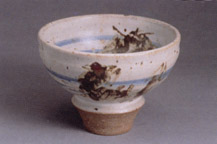 Covered Dish, 1964 (Fig. 66), and Bowl, 1964 (Fig. 67), exemplify the cherished tenets of studio pottery, especially as they have been shaped by the ideals of Bernard Leach. Covered Dish stands on an extended, cylindrical foot; the belly flares outwards, gradually curling and thickening at its extremities to constitute the lip. The lid sits snugly with the knob marking a climax to the form. The vessel is partly glazed; glazed and fired Surfaces are juxtaposed in order to vary passages of textural and chromatic changes over the surfaces. The ornament consists of sprays of bamboo which are brushed lightly on the body and lid; they appear as cast shadows rather than embodied or inscribed shapes.
Covered Dish, 1964 (Fig. 66), and Bowl, 1964 (Fig. 67), exemplify the cherished tenets of studio pottery, especially as they have been shaped by the ideals of Bernard Leach. Covered Dish stands on an extended, cylindrical foot; the belly flares outwards, gradually curling and thickening at its extremities to constitute the lip. The lid sits snugly with the knob marking a climax to the form. The vessel is partly glazed; glazed and fired Surfaces are juxtaposed in order to vary passages of textural and chromatic changes over the surfaces. The ornament consists of sprays of bamboo which are brushed lightly on the body and lid; they appear as cast shadows rather than embodied or inscribed shapes.
Bowl (Fig. 67) is elevated on an extended foot; the belly emerges gradually through ringed indentations, and flares outwards at a measured pace. The internal space is deep and evenly spread. The entire body is glazed; the interior and exterior are decorated with crab motifs. The uniform treatment of the glazed surface is contrasted with the rigorous, agitated brushmarks denoting crabs. The ornament appears to intrude into and disrupt an otherwise tranquil atmosphere.
The two vessels appeal by their simplicity and modesty; their proportions and method of fabrication spring from guarded understatement rather than from aggressive declarations, Yet they assert distinct presences; in viewing them one is self-conscious of encountering expressive objects whose aesthetic values outweigh their utility; and they are cherished for these values.

 Vase, 1964 (Fig. 68) and Coffee Pot, 1964 (Fig. 69), demonstrate the enlarged interest in glazing techniques and effects. Eng Teng employs the temmoku glaze which is characterised by a dark brown hue sometimes enlivened by rusty streaks. The two vessels are ornamented with bamboo sprays, applied by the wax-resist technique; the sprays are confined to the region of the shoulders. This particular range of glazes adds immensely to the three dimensional presence of the vessels; they are in turn opaque and translucent. Opacity serves to separate the object from its surroundings, thereby securing for it a degree of spatial autonomy. Translucency, on the other hand, connects the object to its environment disclosing, continuously changing aspects or viewpoints. In dwelling on these glazes one is conscious of highlights on the surface and their relationship with the contours of the vessels; consequently their volume and shapes are powerfully appreciated.
Vase, 1964 (Fig. 68) and Coffee Pot, 1964 (Fig. 69), demonstrate the enlarged interest in glazing techniques and effects. Eng Teng employs the temmoku glaze which is characterised by a dark brown hue sometimes enlivened by rusty streaks. The two vessels are ornamented with bamboo sprays, applied by the wax-resist technique; the sprays are confined to the region of the shoulders. This particular range of glazes adds immensely to the three dimensional presence of the vessels; they are in turn opaque and translucent. Opacity serves to separate the object from its surroundings, thereby securing for it a degree of spatial autonomy. Translucency, on the other hand, connects the object to its environment disclosing, continuously changing aspects or viewpoints. In dwelling on these glazes one is conscious of highlights on the surface and their relationship with the contours of the vessels; consequently their volume and shapes are powerfully appreciated.
Attributes such as spatial autonomy, the appreciation of volume and shapes point to what is known in art as plasticity. This refers to the real or apparent three-dimensionality of art works and their interaction with the surrounding space. Cast in this light, pottery and and sculpture share some grounds. For the moment it is the analogy between pottery and plasticity that is of interest. And in discussing it I turn to the second of two issues mentioned as arising from Eng Teng's account of the goals of studio pottery. The first, which has been dealt with, has to do with throwing and its encompassing implications. The second springs from his remark that for the studio potter to be distinguished from past and prevailing traditions "you have to be more."
If this injunction is left dangling all by itself it could be read as no more than a tease. However, Eng Teng qualifies it in an important and detailed manner:
I am actually distorting my pots quite a bit; I don't leave a pot clean, as it thrown on the wheel. I like to torture it or sculpt onto it. I add here and there or subtract from the actual thrown form itself. By so doing, you inject a little of your personality in it and your identity also. (Ibid.)
This qualification marks an appreciable shift from a disclosure cited earlier in which the relationship between utility and expressivity, while mentioned, was couched in ambivalent terms: now the emphasis is towards gaining individuality for the object, towards registering an inimitable presence. In aiming to develop these goals utility is bypassed.
The key notion is distortion; by this Eng Teng advocates breaching conventions, inessing around rather than leaving the pot "clean". In other words the orthodox, dependable appearance of a vessel is replaced by complex, shifting forms; the consistent silhouette of the rounded pot is now altered or interrupted to give rise to changing viewpoints. Symmetry is replaced by asymmetry; colour and pattern are complicated and are given prominence. Walls are pinched, gouged and flattened, surfaces are matt, dry and uneven, rather than glossy and curvaceous. Whereas harmony and equilibrium pinailed in traditional pottery, contrast and equivocation characterise the new ceramics.
Eng Teng enlists sculptural aspects or methods in achieving some of his goals, in doing so he widens the grounds for ceramic activity. Conversely the development of his sculptural activity is affected by studio pottery concepts and procedures; in this regard, commentaries on Eng Teng have drawn attention to pottery as the wellspring of his sculptural practice. The relationship between contemporary pottery and sculpture is complicated. In part the difficulties stem from a prejudice against clay as a sculptural medium, rooted in the fact that clay has been a useful material employed to produce a range of artifacts; invariably discussion of issues arising from this bias leads to the divide separating high from low art. in part the difficulties revolve around the relative youthfulness of sculptural ambitions or intentions in contemporary ceramists; it is possible that with time, ceramic-sculptors will create bodies of work which enable the establishment of values and criteria regarding the interdisciplinary nature of this practice.
Eng Teng acknowledges the indeterminate state of the relationship and of studio pottery; in doing so he describes the scope of his interests and the genres into which his works can be categorised:
There are the pure, simple forms of pots, very functional, nothing more. Thep there are semi-functional works which are neither pots nor sculptures. Then there are pure figurations, sculptural works. There also are very abstract forms and at the same time semi-symbolic forms. I am not set in one direction. I reach into many different paths at one time. (Ibid.)
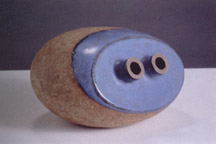 A work aptly designated as Pot-Sculpture (Fig. 70), which can be attributed to 1971 - 72, gives an intimation of the consequences of some of these developments. The dual designation can be interpreted as a symptom of indeterminacy; accordingly, a sense of belonging to a distinctive class or group is compromised to the extent that a notion of a singular identity is jeopardised. It can also be read as pointing to a hybrid creation arising from a fusion of two different art categories; the outcome manifests characteristics from each category, equably. So much so it can be given a title only by naming both the originating categories.
A work aptly designated as Pot-Sculpture (Fig. 70), which can be attributed to 1971 - 72, gives an intimation of the consequences of some of these developments. The dual designation can be interpreted as a symptom of indeterminacy; accordingly, a sense of belonging to a distinctive class or group is compromised to the extent that a notion of a singular identity is jeopardised. It can also be read as pointing to a hybrid creation arising from a fusion of two different art categories; the outcome manifests characteristics from each category, equably. So much so it can be given a title only by naming both the originating categories.
By and large the claims of sculpture appear to prevail in this work. As a pot, it abandons the customary upright stance and the provision of an internal space that is accessible. The object is presented horizontally, as if lying on its side; the surface is curved consistently, giving rise to a form that is mobile rather than one that is anchored as a stabile.
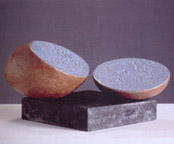 Two protruding openings give entry into an enclosed space whose contents cannot be ascertained. Attention shifts to the plasticity of the form, away from its designation as a pot to that of a work of sculpture; consideration is focused on three-dimensional qualities and their interaction with the environment. Curved planes and planar surfaces are subtly interwoven, prompting changing yet connected aspects. There is a marked kinship between this work and Two Forms, 1971 (Fig. 71); in them Eng Teng deals with some of the fundamental issues in sculpture. He does so after his return to Singapore (1966) and after establishing his practice proper in 1969.
Two protruding openings give entry into an enclosed space whose contents cannot be ascertained. Attention shifts to the plasticity of the form, away from its designation as a pot to that of a work of sculpture; consideration is focused on three-dimensional qualities and their interaction with the environment. Curved planes and planar surfaces are subtly interwoven, prompting changing yet connected aspects. There is a marked kinship between this work and Two Forms, 1971 (Fig. 71); in them Eng Teng deals with some of the fundamental issues in sculpture. He does so after his return to Singapore (1966) and after establishing his practice proper in 1969.
Eng Teng journeyed to England in order to further his studies in ceramics; his resources, as a student and as a professional designer, were largely directed towards achieving this aim. Yet, he did not completely neglect his earlier preoccupation, namely: painting and drawing. His formal studies were devoted to pottery; even so, his engagement with drawing and painting was sustained, spurred by his own interest. And the interest was serious and deep. An illustration of his commitment to one of these areas is illustrated by the decision to enlist in a course on drawing when he enrolled in Farnham School of Art. This was prompted by the need to strengthen his facility in life drawing which, he felt, was insufficiently developed while he was in NAFA.
Although the practice of painting and drawing while in England was pursued optionally, Eng Teng has produced an appreciable body of work which demonstrates advancement along conceptual and formal grounds. Occasionally, he displayed his pictures in exhibitions. In maintaining and deepening his involvement with painting and drawing, it is possible to map paths of continuity in his development even though his directions were altered substantially.
As in the past, for subject matter Eng Teng turned to his environment; he was interested in his habitat, the city, the countryside, as well as persons whom he encountered by chance and those who remained as friends. Consequently the principal picture categories that emerged were landscapes, cityscapes and portraits; to these must be added studies featuring the figure.
 From the English Window, 1962 (Fig. 72), discloses a view of a street in Stoke-on-Trent through the window of his flat; the interior is suggested by the pattern on the windowcurtain. Eng Teng comes close to the window and looks at the view directly. A leafless tree appears immediately outside the window; the road winds through rows of houses. It is an intimate view, emerging from Eng Teng's increasing familiarity with his surroundings. There is variety in the employment of lines; the tree and enclosure of the compound below are represented in detail. Lines are gathered in dense clusters to convey depth. The houses are sketched lightly, indicating their position in space and to one another.
From the English Window, 1962 (Fig. 72), discloses a view of a street in Stoke-on-Trent through the window of his flat; the interior is suggested by the pattern on the windowcurtain. Eng Teng comes close to the window and looks at the view directly. A leafless tree appears immediately outside the window; the road winds through rows of houses. It is an intimate view, emerging from Eng Teng's increasing familiarity with his surroundings. There is variety in the employment of lines; the tree and enclosure of the compound below are represented in detail. Lines are gathered in dense clusters to convey depth. The houses are sketched lightly, indicating their position in space and to one another.
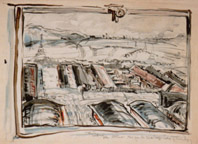 In View of Stoke-on-Trent from North Staffordshire College of Technology, 1962 (Fig. 73), Eng Teng shifts from looking at his environment from the intimacy of his domestic habitat to presenting a sprawling industrial settlement. Whereas the atmosphere in the former is tranquil, here it is volatile. The hills in the background are deforested; the extensive valley is implanted with pylons which march into the distance; the sky appears leaden. The middle and foregrounds are occupied by featureless buildings; the earth appears scarred. These readings are stimulated by the expressive use of the medium; linear and painterly devises are employed effectively and give rise to powerful symbolic and emotional reactions.
In View of Stoke-on-Trent from North Staffordshire College of Technology, 1962 (Fig. 73), Eng Teng shifts from looking at his environment from the intimacy of his domestic habitat to presenting a sprawling industrial settlement. Whereas the atmosphere in the former is tranquil, here it is volatile. The hills in the background are deforested; the extensive valley is implanted with pylons which march into the distance; the sky appears leaden. The middle and foregrounds are occupied by featureless buildings; the earth appears scarred. These readings are stimulated by the expressive use of the medium; linear and painterly devises are employed effectively and give rise to powerful symbolic and emotional reactions.
The most marked advancement can be seen in the drawings from life executed while he was studying in Farnham School of Art; although the duration of his studentship was brief and, in any case, it was chiefly aimed at developing his interest in studio pottery, these pictures show remarkable progress. Eng Teng describes the eagerness with which he entered into the study of the subject; be gained immensely from the instruction and demonstrates the benefit in his productions. Very First Life Drawing, 1963 (Fig.74), discloses the rigour expected in drawing the nude as a full figure. The model is seated firmly and Eng Teng assumes a position requiring him to deal with the frontal view; this is a view which entails a comprehensive representation of visual and psychological factors.  The contours of the figure are securely registered; the line is thickened sufficiently, and at intervals, so as to convincingly contain the form. However, components of the body and their connection with one another are not realised clearly and consistently. Towards the top right corner appears a response from the instructor which can be read as a correction of a passage in the drawing and aimed at improving the outcome. It deals with the torso; in comparing the two, the instructor's drawing demonstrates the acuity of seeing and clarity in execution. The relationship between the breasts and the abdomen is compositionaily sound and decisive; graphic elements are employed to convey volume, texture and the effects of light and shade in crystallising form. In a relatively modest rendering, the instructor is able to represent an aspect of the figure concretely and convincingly.
The contours of the figure are securely registered; the line is thickened sufficiently, and at intervals, so as to convincingly contain the form. However, components of the body and their connection with one another are not realised clearly and consistently. Towards the top right corner appears a response from the instructor which can be read as a correction of a passage in the drawing and aimed at improving the outcome. It deals with the torso; in comparing the two, the instructor's drawing demonstrates the acuity of seeing and clarity in execution. The relationship between the breasts and the abdomen is compositionaily sound and decisive; graphic elements are employed to convey volume, texture and the effects of light and shade in crystallising form. In a relatively modest rendering, the instructor is able to represent an aspect of the figure concretely and convincingly.
 These are among the foremost ideals underlying figure drawing in the context of European pictorial tradition; they underline the foundation of instruction in the academy. Eng Teng strives to attain them. Rear View of Model, 1963 (Fig. 75), provides evidence of his progress. Charcoal can be manipulated to register a rich array of linear, tonal and textural effects; Eng Teng exploits these possibilities. The principal shapes (shoulders and torso) have double contours; one set of lines consolidates the particular components while the second set, which parallels the first and is rendered in a lighter tone, suggests shadows cast by the components. The device is simple; yet it immediately imbues the form with a sense of actuality or concreteness. The shoulder blades, the curving back and buttocks are depicted with controlled, expressive graphic techniques; anatomical details are clearly delineated by modulating linear and tonal values.
These are among the foremost ideals underlying figure drawing in the context of European pictorial tradition; they underline the foundation of instruction in the academy. Eng Teng strives to attain them. Rear View of Model, 1963 (Fig. 75), provides evidence of his progress. Charcoal can be manipulated to register a rich array of linear, tonal and textural effects; Eng Teng exploits these possibilities. The principal shapes (shoulders and torso) have double contours; one set of lines consolidates the particular components while the second set, which parallels the first and is rendered in a lighter tone, suggests shadows cast by the components. The device is simple; yet it immediately imbues the form with a sense of actuality or concreteness. The shoulder blades, the curving back and buttocks are depicted with controlled, expressive graphic techniques; anatomical details are clearly delineated by modulating linear and tonal values.
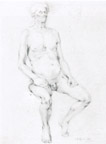 Seated Model, 1964 (Fig. 76), is a portrayal of infirmity arising from ageing. Eng Teng deals with the entire figure; the interest in observing the dimunition of the physique is, generally, sustained. The disproportionate relationship of the arms and hands vividly underlines the unevenness with which the body reacts to ageing. The face conveys apprehension; the head, however, is held upright and with determination. The consequence of this endeavour is captured by the strain in the neck, highlighted by the musculature of the neck and throat which are thrown into high relief. The instructor intervenes by drawing attention to nuances and subtleties involved in the act of observing and the process of representation; he registers these concerns by focusing on the head, detailing the relationship of facial features so as to bring to the surface deeply discerned emotions or feelings.
Seated Model, 1964 (Fig. 76), is a portrayal of infirmity arising from ageing. Eng Teng deals with the entire figure; the interest in observing the dimunition of the physique is, generally, sustained. The disproportionate relationship of the arms and hands vividly underlines the unevenness with which the body reacts to ageing. The face conveys apprehension; the head, however, is held upright and with determination. The consequence of this endeavour is captured by the strain in the neck, highlighted by the musculature of the neck and throat which are thrown into high relief. The instructor intervenes by drawing attention to nuances and subtleties involved in the act of observing and the process of representation; he registers these concerns by focusing on the head, detailing the relationship of facial features so as to bring to the surface deeply discerned emotions or feelings.
Concerns with psychological factors and matters related to constructing identities are central to portraiture, for Eng Teng these are not new interests. His sustained efforts at imaging the self and others have been discussed in some detail in the preceding chapter. He continues with his commitment to these issues and produces a number of portraits; occasionally he turns his attention on the self.

 Compared with the composition in Fig. 56, Self Portrait, 1963 (Fig. 77), is an image imparting confidence. Executed while studying at Farnham School of Art, he appears settled and in control of his circumstances; by his own admission he found this institution conducive for realising his aims as an artist. Eng Teng positions his image towards the bottom left corner in order to accentuate a sense of intimacy or availing himself to confidential disclosures. His stance is forthright; he is posed frontally, looks directly out and engages the gaze of the viewer candidly.
Compared with the composition in Fig. 56, Self Portrait, 1963 (Fig. 77), is an image imparting confidence. Executed while studying at Farnham School of Art, he appears settled and in control of his circumstances; by his own admission he found this institution conducive for realising his aims as an artist. Eng Teng positions his image towards the bottom left corner in order to accentuate a sense of intimacy or availing himself to confidential disclosures. His stance is forthright; he is posed frontally, looks directly out and engages the gaze of the viewer candidly.
Eng Teng takes great pains to demonstrate the depth and variety of his capacity in drawing. The collar of his shirt and that of his pullover are realised with delicate, undulating lines; some of them turn around on themselves, producing subtle shadows and intricate patterns indicating texture. The face, on the other hand, is modelled forcefully; ears, eyeglasses, right check and hair are rendered with lines arranged in different ways and tonal values to register weight and density. Contrasted with the faintly drawn architectural fragments in the background, the head appears fulsome and assertive. Eng Teng projects an assured presence of the self.
 Rev. W. Short of Croydon, London, 1964 (Fig. 78), displays the extent to which Eng Teng's interest in drawing has shifted or altered from his endeavours while he was a student at NAFA; it also exemplifies his absorption of the ideals of drawing shaping European pictorial traditions and as propagated in academies of art. Whereas in the past drawing was employed to separate or distinguish entities and objects from one another, now the interest is in representing seen reality in detail and specifically; whereas in the past relationships of entities in space were suggested, now the aim is to secure firm and perceptible connections between objects and their environments, or between figures and their ground. In Rev. W Short of Croydon these aims have, in part, been achieved by depicting minute details of facial features; Eng Tong zooms in close and scrutinises the face unsparingly. The folds of the skin on the cheeks and nose, the curving plane of the forehead, clusters of thinning hair are all represented forcefully and distinctively. Each of these components invites and sustains prolonged viewing. In part attributes such as specificity and concreteness are imparted by the integration of these components in order to form a coherent entity; consequently, one encounters an image of a distinct person captured at a particular time and space.
Rev. W. Short of Croydon, London, 1964 (Fig. 78), displays the extent to which Eng Teng's interest in drawing has shifted or altered from his endeavours while he was a student at NAFA; it also exemplifies his absorption of the ideals of drawing shaping European pictorial traditions and as propagated in academies of art. Whereas in the past drawing was employed to separate or distinguish entities and objects from one another, now the interest is in representing seen reality in detail and specifically; whereas in the past relationships of entities in space were suggested, now the aim is to secure firm and perceptible connections between objects and their environments, or between figures and their ground. In Rev. W Short of Croydon these aims have, in part, been achieved by depicting minute details of facial features; Eng Tong zooms in close and scrutinises the face unsparingly. The folds of the skin on the cheeks and nose, the curving plane of the forehead, clusters of thinning hair are all represented forcefully and distinctively. Each of these components invites and sustains prolonged viewing. In part attributes such as specificity and concreteness are imparted by the integration of these components in order to form a coherent entity; consequently, one encounters an image of a distinct person captured at a particular time and space.
 Turning away from the category of portraits and towards still life briefly, comparable conceptual and formal accomplishments can be appreciated in My Boots, 1964 (Fig. 79). In viewing it, the analogy with a picture by Vincent van Gogh is obvious and unavoidable. Imagery such as this can be interpreted as oblique ways of imaging the self. While in England, Eng Teng continued to produce paintings; the majority of the Pictures were executed while he was studying in Stoke-on-Trent and in Farnham. The preferred subject was portraits with secondary interest in landscape. As in the development of his drawings, in his paintings too, Eng Tong demonstrates marked versatility in the employment of the medium, and depth in consolidating pictorial design and content. In these respects Elaine, 1963 (Fig. 80), and My Neighbour, 1963 (Fig. 81), mark the crest of his involvement with painting in which the abiding goal is in constructing representational images.
Turning away from the category of portraits and towards still life briefly, comparable conceptual and formal accomplishments can be appreciated in My Boots, 1964 (Fig. 79). In viewing it, the analogy with a picture by Vincent van Gogh is obvious and unavoidable. Imagery such as this can be interpreted as oblique ways of imaging the self. While in England, Eng Teng continued to produce paintings; the majority of the Pictures were executed while he was studying in Stoke-on-Trent and in Farnham. The preferred subject was portraits with secondary interest in landscape. As in the development of his drawings, in his paintings too, Eng Tong demonstrates marked versatility in the employment of the medium, and depth in consolidating pictorial design and content. In these respects Elaine, 1963 (Fig. 80), and My Neighbour, 1963 (Fig. 81), mark the crest of his involvement with painting in which the abiding goal is in constructing representational images.
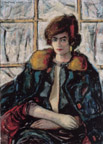 In Elaine, the subject sits in front of a window; the situation provides Eng Teng with an opportunity to compose a picture with varying yet convergent interests. The window frame is used to establish a pattern of lines as in a grid; it acts as a framing device, whereby parts of the figure can be sited or positioned on the picture surface precisely. The subject looks out and meets the viewer steadfastly. Her voluminous coat and its collar are painted in deep blues and reds; the folds of the coat produce undulating shapes which draw the eye into recessed spaces. Contrasts emerge from juxtaposing on the one hand rectilinear and curving patterns of shapes and on the other the finite or measurable and the amorphous.
In Elaine, the subject sits in front of a window; the situation provides Eng Teng with an opportunity to compose a picture with varying yet convergent interests. The window frame is used to establish a pattern of lines as in a grid; it acts as a framing device, whereby parts of the figure can be sited or positioned on the picture surface precisely. The subject looks out and meets the viewer steadfastly. Her voluminous coat and its collar are painted in deep blues and reds; the folds of the coat produce undulating shapes which draw the eye into recessed spaces. Contrasts emerge from juxtaposing on the one hand rectilinear and curving patterns of shapes and on the other the finite or measurable and the amorphous.
 My Neighbour is distinguished by the splendour issuing from the combination of colours and the method of brushing together complexes of coloured paint to simulate fabric, wood and human flesh. Even as these contribute to the dominant impact of the picture, they are not gained at the expense of its composition. That is to say, Eng Teng pays attention to the elements of design; these are prominently displayed in the depiction of the chair, the walls and the figure. The subject appears regally robed and projects a dignified, selfconscious presence. While Eng Teng takes great care in portraying an individual and therefore a particular presence, he is also eager to integrate that very individual with the environment. Hence, the colours of the robe are similar to that of the wall; what is more, the right shoulder and sleeve of the subject are merged with the wall and are therefore indistinguishable from it.
My Neighbour is distinguished by the splendour issuing from the combination of colours and the method of brushing together complexes of coloured paint to simulate fabric, wood and human flesh. Even as these contribute to the dominant impact of the picture, they are not gained at the expense of its composition. That is to say, Eng Teng pays attention to the elements of design; these are prominently displayed in the depiction of the chair, the walls and the figure. The subject appears regally robed and projects a dignified, selfconscious presence. While Eng Teng takes great care in portraying an individual and therefore a particular presence, he is also eager to integrate that very individual with the environment. Hence, the colours of the robe are similar to that of the wall; what is more, the right shoulder and sleeve of the subject are merged with the wall and are therefore indistinguishable from it.
The principal aim in the drawings and paintings produced in Singapore and in England is to consolidate, and subsequently amplify, representational schemes which can vividly symbolise the range of concepts and themes that Eng Teng considers as important. Occasionally he departs from this preoccupation; he does so by modifying representational schemes, at times by using strategies of abbreviation and at other times by elaboration. These explorations are not pursued exclusively but contemporaneously with his leading activities. It may be tempting to refer to these attempts as modes of abstraction; however, such a reference can only be made in a loose or provisional manner.

 So Very Cold, 1962 (Fig. 82), is composed of shapes and graphic marks that interweave incessantly. Closer examination discloses a figure, presented as a compressed entity in which individual features are fused, consolidated, in order to create a compact form. The head is covered by a scarf and wreathed by wiry bruslistrokes of varying thickness and pace. The technical methods employed in this composition bear some similarities to those in He's Alive!, c. 1961 (Fig. 83), although in that picture they are pressed towards a heightened pitch in order to express the horror and bloodshed ensuing from a violent accident. The pronounced foreshortening of the figure enhances the sense of violation, as the form appears distorted. In So Very Cold the figure appears comparably contorted, although the occasion giving rise to this situation is different.
So Very Cold, 1962 (Fig. 82), is composed of shapes and graphic marks that interweave incessantly. Closer examination discloses a figure, presented as a compressed entity in which individual features are fused, consolidated, in order to create a compact form. The head is covered by a scarf and wreathed by wiry bruslistrokes of varying thickness and pace. The technical methods employed in this composition bear some similarities to those in He's Alive!, c. 1961 (Fig. 83), although in that picture they are pressed towards a heightened pitch in order to express the horror and bloodshed ensuing from a violent accident. The pronounced foreshortening of the figure enhances the sense of violation, as the form appears distorted. In So Very Cold the figure appears comparably contorted, although the occasion giving rise to this situation is different.
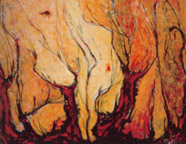 There are two pictures in this collection in which the departure from representational goals assumes pronounced degrees; pronounced, that is, in the context of Eng Teng's pictorial development. As early as 1960 there appears Silhouettes (Fig. 84); the impetus is derived from the female figure cast as performing movements at varying pace. These movements are inscribed as undulating lines, running the height of the picture surface; distinct patterns emerge permitting the reading of movements vertically and laterally, thereby transforming the surface into a volatile entity.
There are two pictures in this collection in which the departure from representational goals assumes pronounced degrees; pronounced, that is, in the context of Eng Teng's pictorial development. As early as 1960 there appears Silhouettes (Fig. 84); the impetus is derived from the female figure cast as performing movements at varying pace. These movements are inscribed as undulating lines, running the height of the picture surface; distinct patterns emerge permitting the reading of movements vertically and laterally, thereby transforming the surface into a volatile entity.
 The second also deals with the human figure; it is titled Study of Guitar Player, 1963 (Fig. 85). In it the figure and the instrument are abbreviated and fused to produce provocative configurations. Of course the approach is not new as Eng Teng employs pictorial idioms derived from Cubism and Constructivism. A variety of arrangements are visible. In the top right corner the figure and guitar are absorbed into one another; the principal figure holds and strums the guitar in a conventional manner while its head is abbreviated and assumes the shape of the guitar's body. Towards the top left corner appears an open form in which the two components (i.e. figure and guitar) surrender their respective formal identities and are fused to produce an imaginary entity. It is apparent that Eng Teng is vigorously exploring ways by which conventional forms can be differently arranged and composed; his explorations avoid descriptive, anecdotal details choosing, instead, to focus on elementary shapes and forms. As goals in drawing and painting they appear infrequently, if not rarely; they do, however, feature prominently in the development of his sculpture which is the subject in the following chapter.
The second also deals with the human figure; it is titled Study of Guitar Player, 1963 (Fig. 85). In it the figure and the instrument are abbreviated and fused to produce provocative configurations. Of course the approach is not new as Eng Teng employs pictorial idioms derived from Cubism and Constructivism. A variety of arrangements are visible. In the top right corner the figure and guitar are absorbed into one another; the principal figure holds and strums the guitar in a conventional manner while its head is abbreviated and assumes the shape of the guitar's body. Towards the top left corner appears an open form in which the two components (i.e. figure and guitar) surrender their respective formal identities and are fused to produce an imaginary entity. It is apparent that Eng Teng is vigorously exploring ways by which conventional forms can be differently arranged and composed; his explorations avoid descriptive, anecdotal details choosing, instead, to focus on elementary shapes and forms. As goals in drawing and painting they appear infrequently, if not rarely; they do, however, feature prominently in the development of his sculpture which is the subject in the following chapter.
On completing his studies Eng Teng was appointed as the residential designer at Carrigaline Pottery Factory in County Cork, Ireland; he remained in this position for two years. He derived immense satisfaction from his professional engagement as well as facilities extended to him so that he could pursue his artistic interests, especially in studio pottery. He describes the happy circumstances clearly, vividly:
Well, I was there for nearly two years. Good job, good pay, life was getting comfortable; I didn't have to depend on any money sent from home, I was earning and saving and in fact when I had to return, I paid my own passage, imported an electric furnace, a kiln, potter's wheel and some ceramic materials to start my workshop in Singapore. (Conversations, p. 161.)
What prompted him to return? Firstly, there was his ambition to establish his studio to commence his ceramic practice. This is hardly surprising as it was for this reason that he set out in pursuit of advancing his education in pottery in England. Secondly, there was concern for his family, especially his parents; he wanted to be of assistance and support to them. Eng Teng recounts this matter in the following words: "When I left in 1962, I left with a lousy impression; I was unpleasant, unhappy; I was all bogged down with poor health and anxiety, my future was uncertain and questionable. So after I had done so well in health and life I thought I must come back before it was too late." (Conversations, p. 163.) The circumstances he describes correspond with the time when he produced his self portraits in 1961 and 1962; their tenor may well have sprung from the conditions revealed in this disclosure. There was yet another factor determining his return:
And the third reason I came back was because before I left, Mdrn Chen had told students that she hoped eventually some would come back to help NAFA; I thought maybe I could help to start a pottery workshop~ but the suggestion was not taken up at all by the Academy. (Ibid.)
The suggestion was not accepted and nothing materialised from it. Eng Teng acted upon a number of initiatives. Firstly, he set about installing a workshop-cum-studio in his home, at the suggestion and with active help of his father. He inaugurated his practice by designing a series of figures for slip casting; realising the overtly commercial implications of this process, he shifted to press moulding, a procedure he considered as possessing some artistic merit. Still, these were produced chiefly for monetary purposes and the project was not successful. Secondly, realising that his resources were depleting he decided to seek employment; he was not able to secure work that was compatible with his qualifications and artistic interests. On tne recommendation of Vincent Hoisington, and in desperation, he secured a position as a visual aids designer at the International Planned Parenthood Federation, an affiliate of UNESCO.
Thirdly, he continued with his creative work; notwithstanding the diverse, competing commitments, Eng Teng did not neglect his artistic practice. It could only be undertaken optionally, during the hours intervening between the conclusion of a working day and sleep. Even so, he persisted and gradually this engagement increased its demand on intellectual and physical resources. Eng Teng describes the circumstances and subsequent settlement in detail:
I was producing works in my spare time, exhibiting them in group exhibitions; interest in my art practice was getting more serious. Often I worked late into the night and found it not satisfactory that I had to set off to office the next morning. I stopped, and began a full-time career in art at the end of 1969. (Conversations, p. 166.)
There also were specific objectives which spurred him towards making his decision:
In 1969 Singapore was commemorating the 150th anniversary of its founding and Dr Nalla Tan, the principal of Eusoff College, instead of spending money on feasting, commissioned me to produce a piece of sculpture for her college titled "Women's Aspirations". So that really got me busy. And then I wanted to prepare for a solo exhibition to display works I had done, from the time at NAFA, to North Staffordshire College of Technology, Farnham School of Art and including recent works completed after returning home from Europe. (Ibid.)
It is with a discussion of the last mentioned event that I conclude this chapter. Just as he marked his departure to England with an exposition, he intended to register his return and, more importantly, the commencement of his art practice professionally also with an exhibition. Departures and returns are milestones in any life, and are commemorated. For artists, such passages are usually signalled by displays of their creative work; in doing so they furnish grounds for the public to ascertain their accomplishments, measure their development and secure for them a niche or stature in the art world. Eng Teng was determined to provide a comprehensive display, approximating a retrospective.
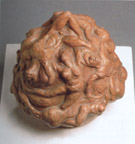
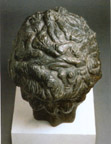 The show, his first solo effort held in 1970, consisted of 77 works; the selection was made from drawings, paintings, pottery and sculpture and spanned ten years of his practice. Among the works displayed and which are now in this collection are: My Boots, So Very Cold, Mending Nets, Preparing Rice Flour, Life is Hard (in oil and ink), View from Bukit Timah Hill (in oil and ink), Tragedy of War I & II, Declining Man, Do We Look Down? and Singapore 150 (image not available).
The show, his first solo effort held in 1970, consisted of 77 works; the selection was made from drawings, paintings, pottery and sculpture and spanned ten years of his practice. Among the works displayed and which are now in this collection are: My Boots, So Very Cold, Mending Nets, Preparing Rice Flour, Life is Hard (in oil and ink), View from Bukit Timah Hill (in oil and ink), Tragedy of War I & II, Declining Man, Do We Look Down? and Singapore 150 (image not available).
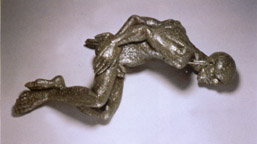
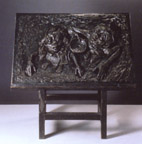 It is equally important for Eng Teng that his re-entry into the art world in Singapore is authorised by those who have been immensely influential in shaping his practice as well as his thinking on art, and who occupy positions of stature in that world. In the publication accompanying the 1962 exposition he invited Ma Ge and Chen Chong Swee to intercede. In 1970, the catalogue featured an introduction by Georgette Chen and a detailed analysis of his oeuvre by Liu Kang; there also were contributions by Chen Jen Hao and Chia Wai Hon. In this regard Eng Teng has cultivated a close relationship with writers on art, consistently featuring a range of opinions and critical approaches to his art in conjunction with his exhibitions.
It is equally important for Eng Teng that his re-entry into the art world in Singapore is authorised by those who have been immensely influential in shaping his practice as well as his thinking on art, and who occupy positions of stature in that world. In the publication accompanying the 1962 exposition he invited Ma Ge and Chen Chong Swee to intercede. In 1970, the catalogue featured an introduction by Georgette Chen and a detailed analysis of his oeuvre by Liu Kang; there also were contributions by Chen Jen Hao and Chia Wai Hon. In this regard Eng Teng has cultivated a close relationship with writers on art, consistently featuring a range of opinions and critical approaches to his art in conjunction with his exhibitions.
In her introduction Georgette Chen provides a detailed account of her role in persuading Eng Teng to study pottery in England; she proceeds to make astute observations on the constitution of the art world in Singapore, underlining some of its limitations or inhibitions. She then offers the following diagnosis of Eng Teng's work and its symbolic significance:
His forms are usually full, solid, unadorned and often have heart-rending expressions. This is due to his compassion for human suffering in our midst such as poverty, over-population, strife, which he feels deeply and which he portrays. His constant feeling is that man is bound hand and foot and is prevented from a full blossoming of what Bergson called our elan vital ... hence his "Captives" and "Bondage". He gets so steeped in them that his figures look agonized and tortured. ('Ng Eng Teng')
Chen credits Eng Teng with a deep social consciousness, one which shapes the content, appearance and form of his works. She rightly draws attention to the pronounced states of distress conveyed by a number of the figures; however, not all compositions in this exhibition deal with such aspects. It can also be added that the symbolising of "agonized and tortured" conditions have to do with expressions of inner feelings as well as with difficulties encountered in relating to the environment. Chen also imputes that the depth of Eng Teng's consciousness is such that the Work and the artist are fused and indivisible; she remarks that "he gets so steeped in them." Chen does detect an appreciable shift in the tenor of the works, especially in the representation and treatment of the female figure; consequently, "his heart speaks a language sweeter, softer and kinder though nonetheless true." (Ibid.)
There is one matter which requires comment. In drawing an analogy with Bergson, Chen flaws her argument; she interprets the notion of elan vital as being the other or opposite to conditions of social deprivation and economic poverty; nothing could be further from the case. Bergson advocated it in reaction to the dominant ideals in European philosophical traditions. It was offered as an alternative to the logical, rational conceptualization of the world; he urged that life was paramount and could not be reduced to deterministic terms, and that logic was no more than one of its by-products. He conceived of reality as a flowing unity giving rise or leading to an organic whole. Still, Chen's introduction emphasised the emotional, psychological tenor of Eng Teng's work and rooted these resonances in social consciousness; in doing so, she drew attention to an enduring aspect of his art.
Applauding Eng Teng as "multi-talented", Liu Kang examines the art historical and aesthetic foundations of the emerging artist's practice, suggests a broad philosophical framework and ends his critique on a bemused note. He distinguishes two clusters of interest; in one the concern is with "content and meaning." By and large the productions in this cluster are shaped by "a humanistic view" and "ideas or views about society"; in highlighting this aspect, Liu Kang's and Georgette Chen's views converge. The other, he observes, deals principally with formal values such as "the rhythms of pure lines, contrasts between solid and void, interplay of three-dimensional forms, forthright versus accommodating nature of shapes, as well as overall presentation of beautiful forms." ('The Multi-Talented Ng Eng Teng') This is an impressive catalogue of attributes arising from a rigorous scrutiny of the works; indeed it marks the first sustained analysis of the formal dynamics of Eng Teng's compositions.
Liu Kang proceeds to establish the historical precedents of Eng Teng's sculptural practice; he identifies Jacob Epstein (1880-1959) as the dominant influence. In doing so he bypasses Jean Bullock who was instrumental in stimulating Eng Teng in developing his knowledge of sculpture. Be that as it may, Liu Kang rightly positions Epstein "between tradition and abstraction" and singles out his "ability" to reflect the spirit of the age; above all, "Epstein is not hung up on tradition, nor is he a slave of fashionable style." (Ibid.) These are powerful claims and in forwarding them Liu Kang is empowering Eng Teng with comparable individuality and integrity.
Liu Kang turns to viewing the paintings and drawings on display; in doing so he highlights the role of drawing as fundamental to all visual arts, including "sister arts" such as architecture, interior design and graphic arts. He acknowledges Eng Teng's capacities in these realms and declares that the pictures "are good enough to stand on their own right as a painter's oeuvre" and that "the quality of his paintings is certainly on par with that of his sculpture." (Ibid.) It is in the face of this versatility, it is in encountering the consistency of performance at all levels that Liu Kang appears bemused. He concludes his critique on a rhetorical tone; "Eng Teng has so many talents; so how do we reckon with him?" (Ibid.)
Sabapathy, T.K. '3 Dialogues Ng Eng Teng, Iskandar Jalil, John Tan' in Conversation with T.K. Sabapathy, in Sabapathy T.K., Transformation Image: Contemporary Ceramics in Singapore, National Museum Art Gallery, Singapore, 1987.
Last updated: 11 January 2001